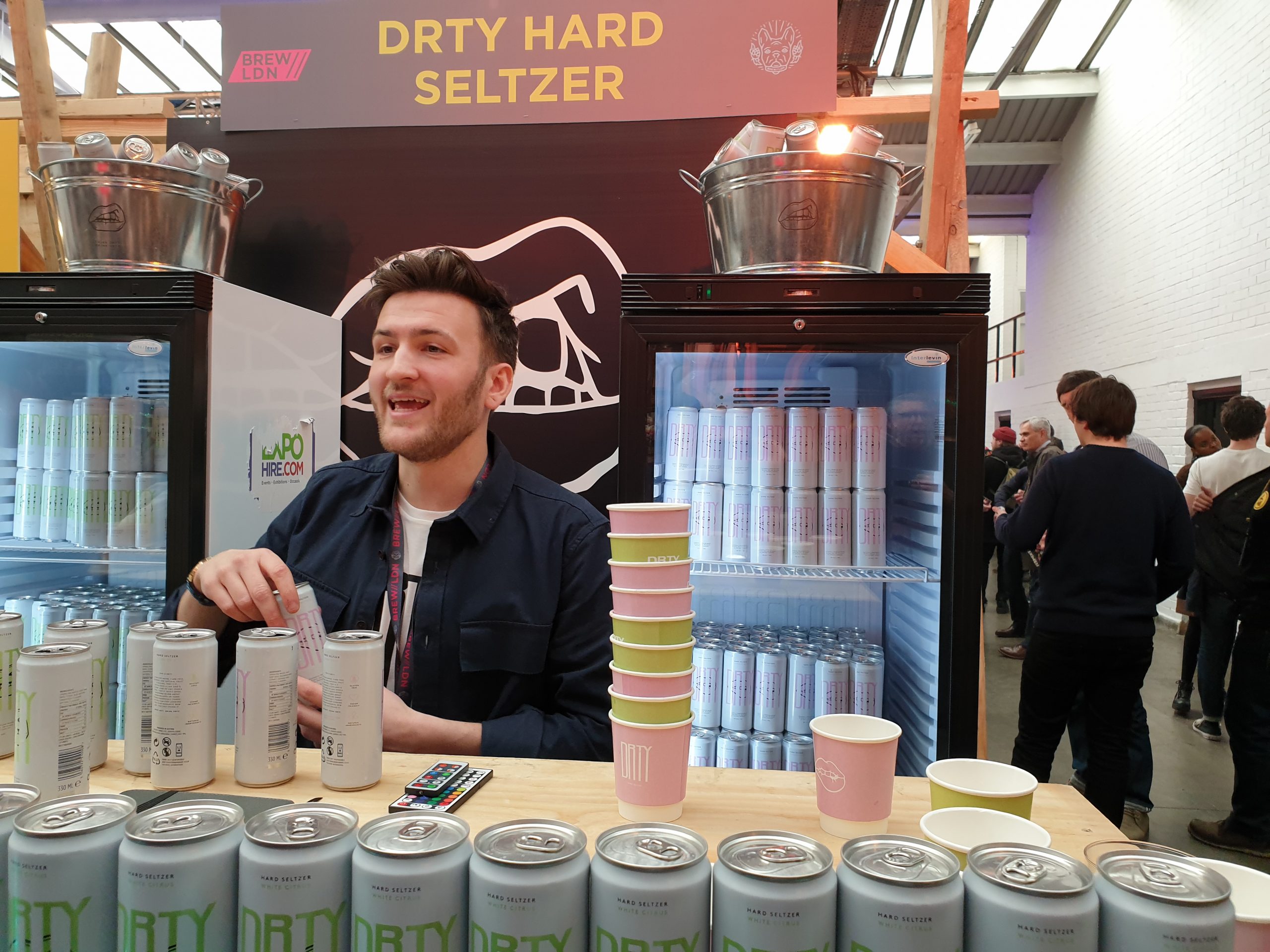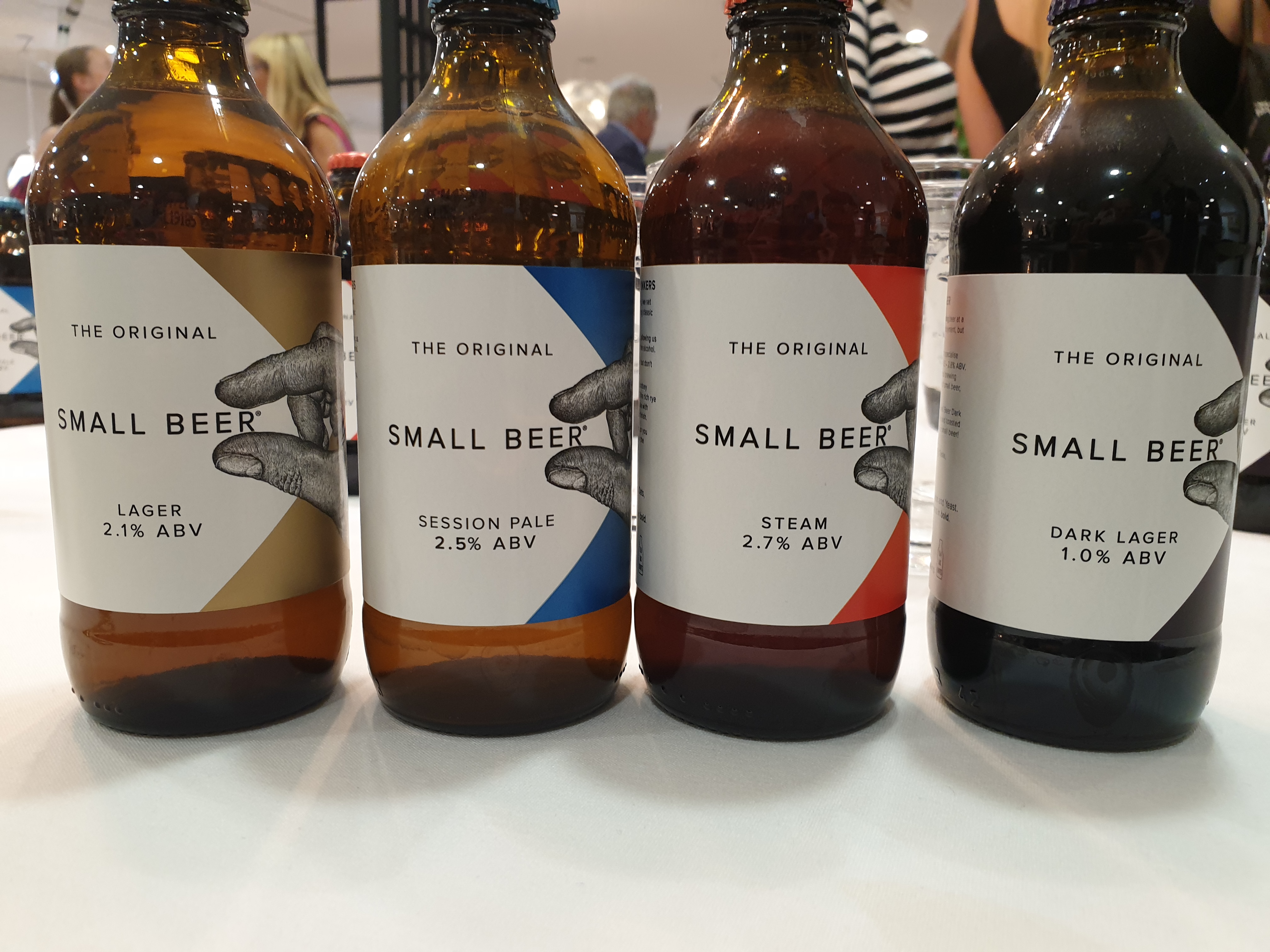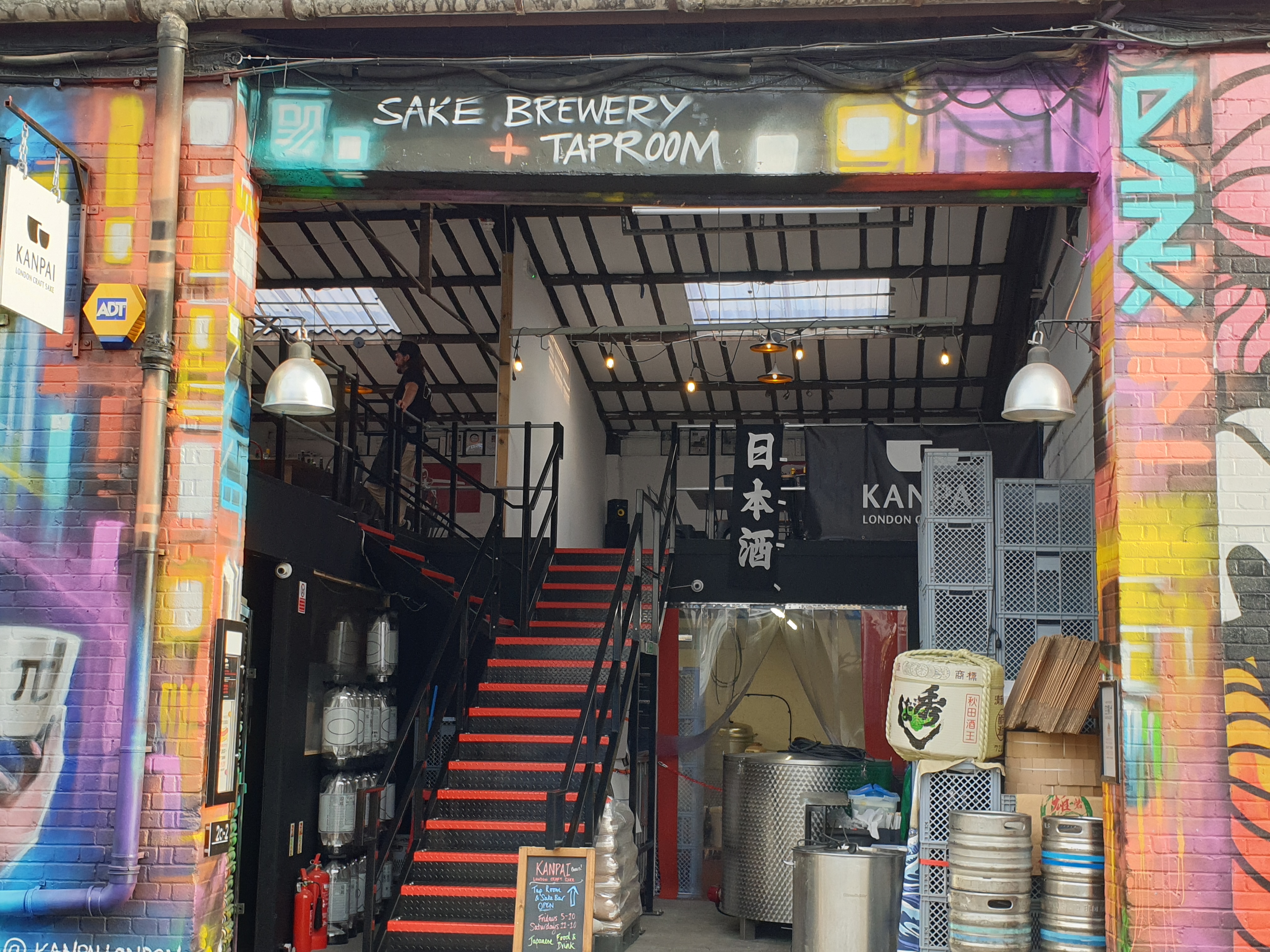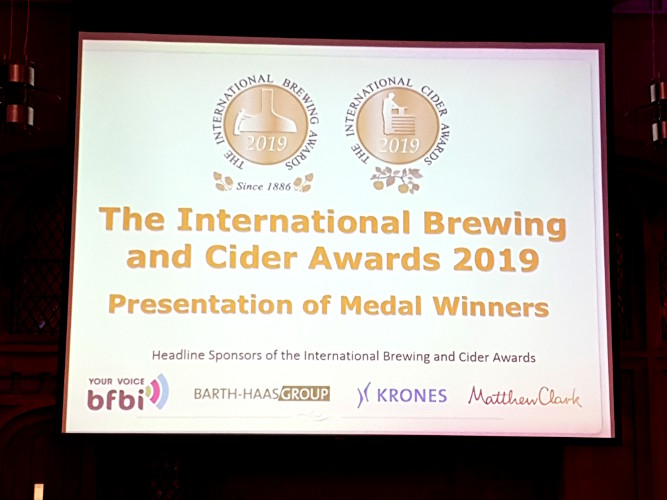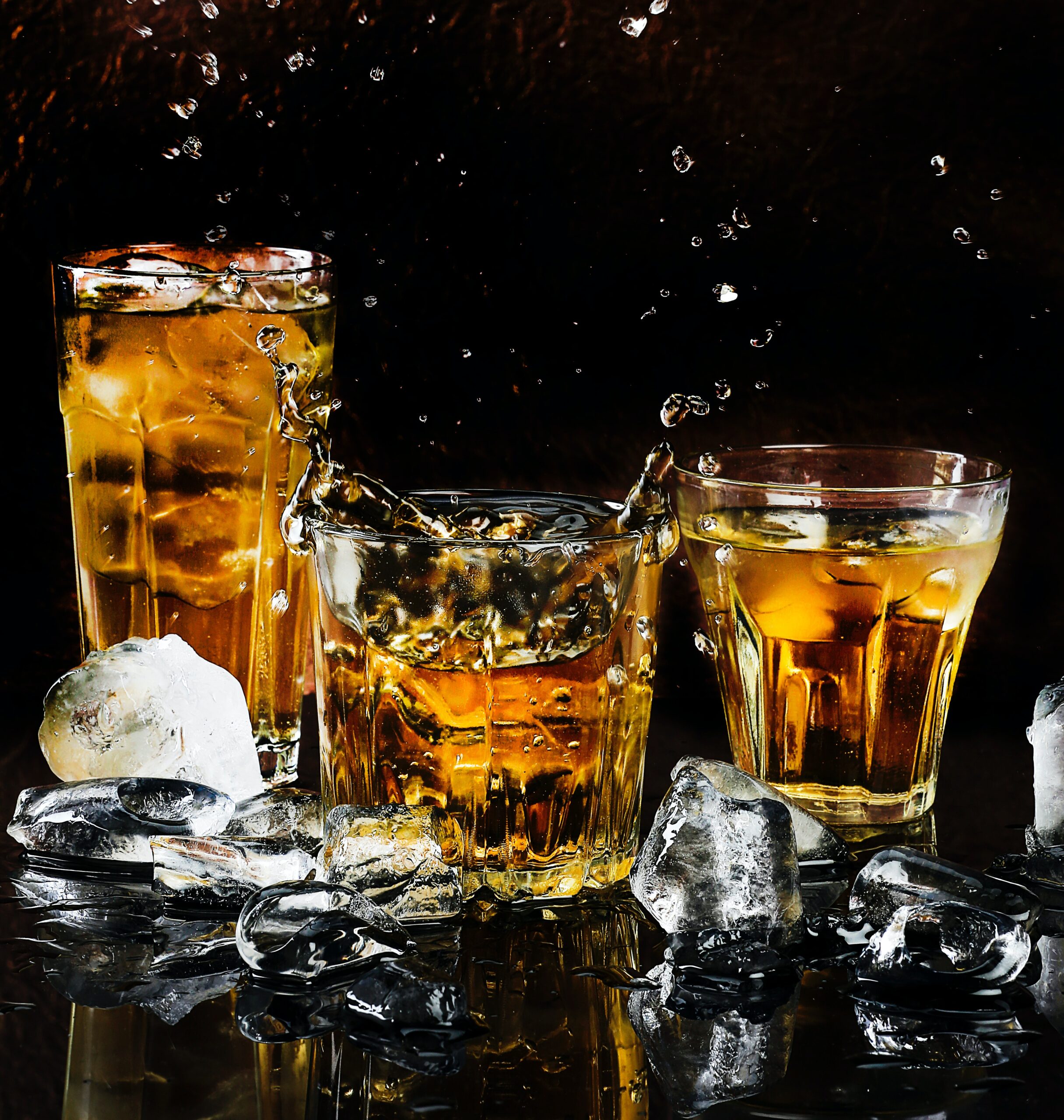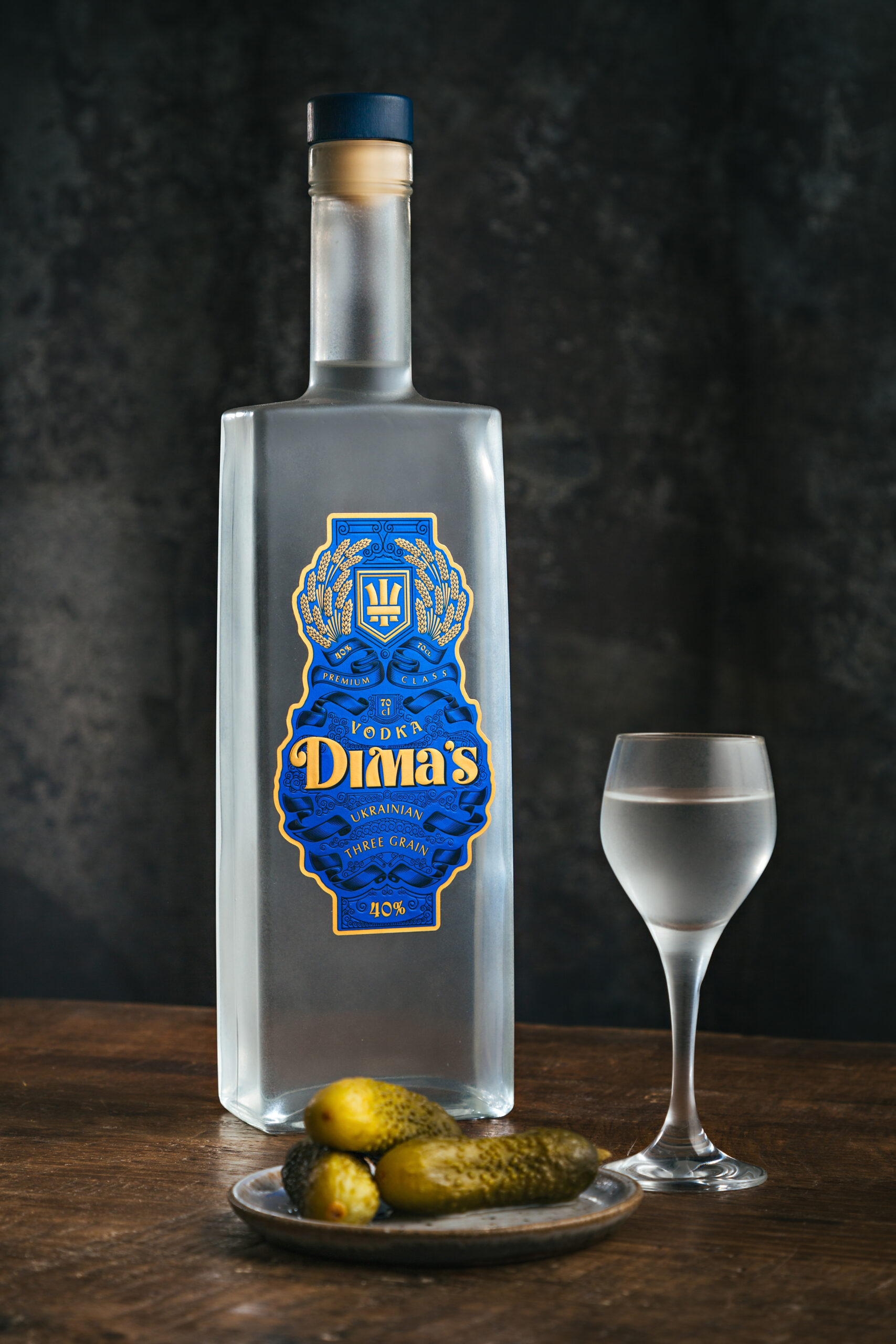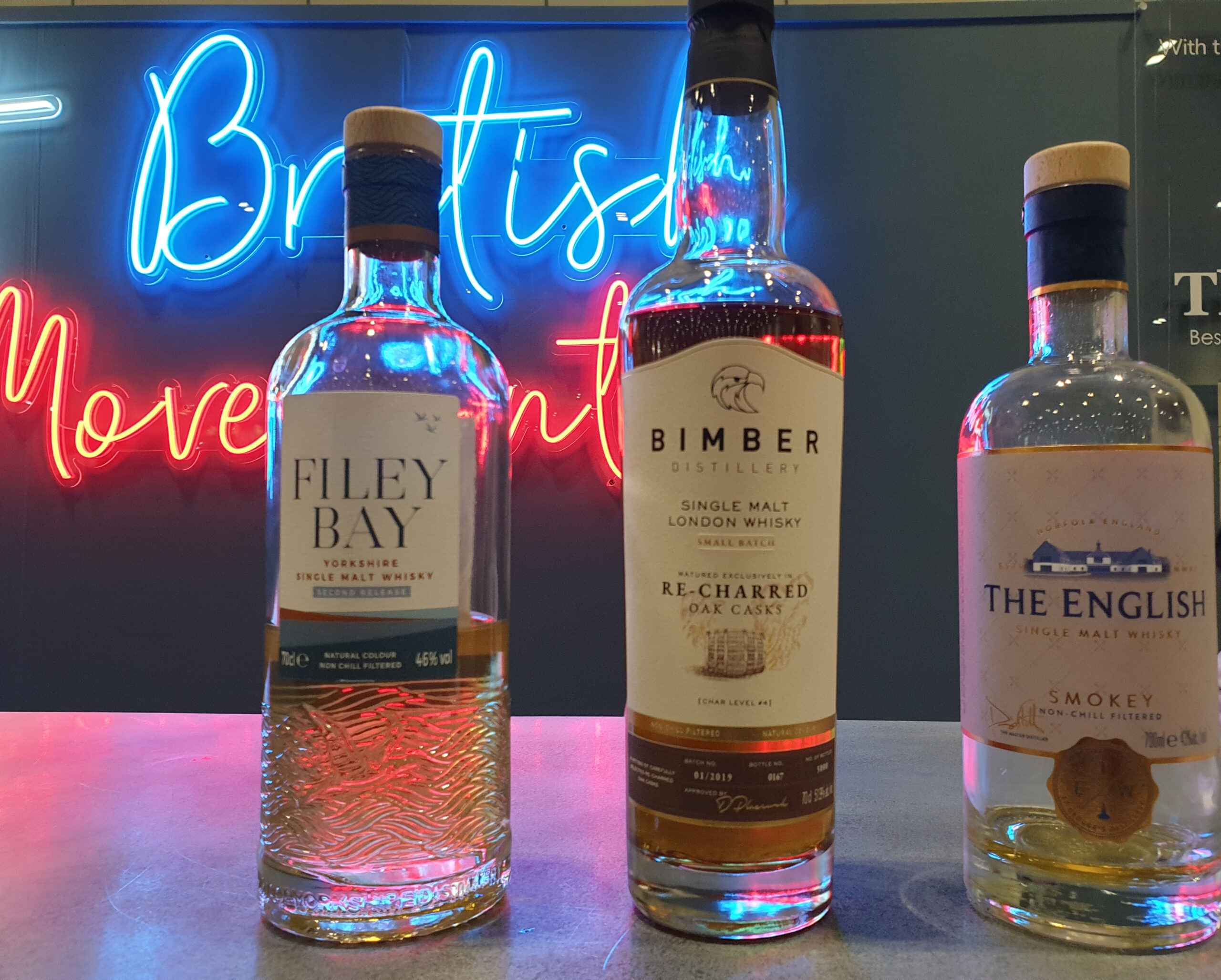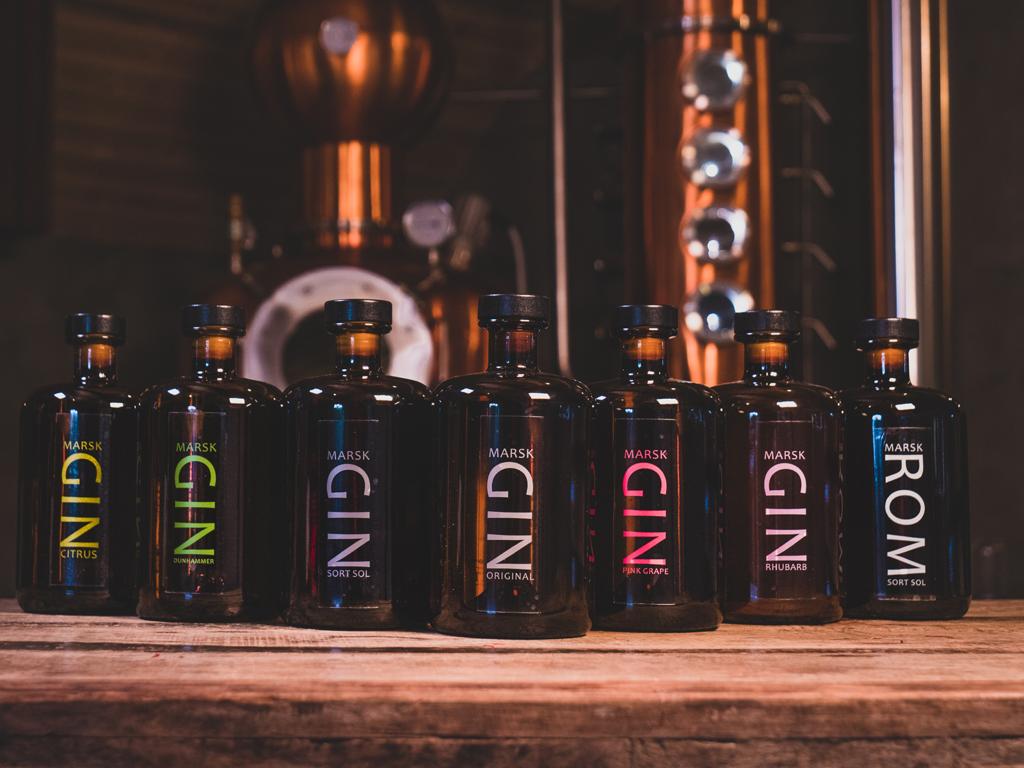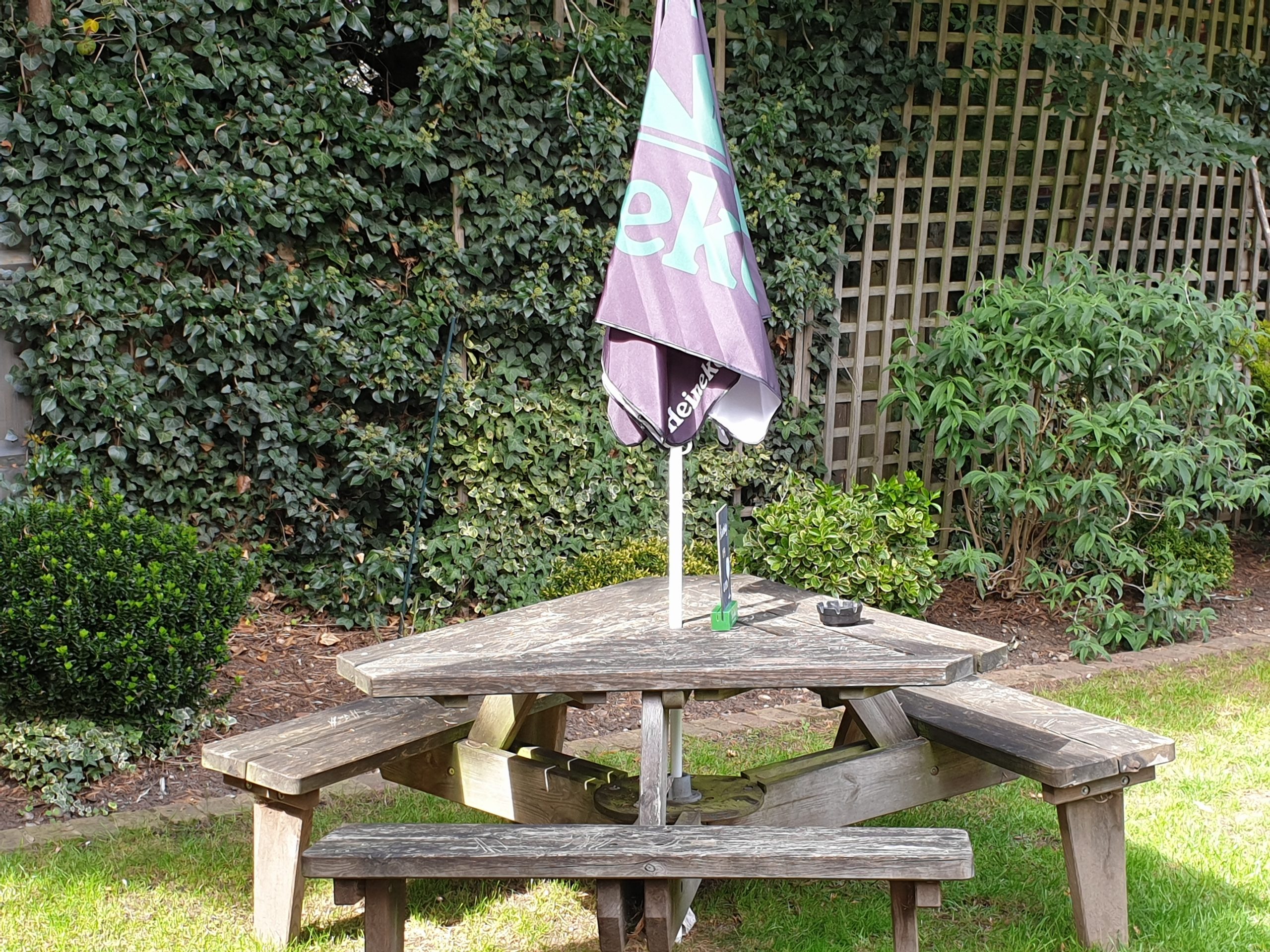ENQUIRE NOW
ENQUIRE NOW
NEW EQUIPMENT
Home | You searched for “no alcohol” | Page 2
Hard Seltzer: the new drinks craze making waves in the UK!
The drinks scene is definitely getting ‘harder’! No – this doesn’t mean a return to booze-ridden fights on the football terraces. The UK is beginning to embrace the latest trend that has swept the US by storm. Hard Seltzer is the new category that’s shaking up the drinks market, adding its very own sparkle!
Hard Seltzer popularity
Nielsen CGA reports that there were 7.5 million new drinkers in the American on-trade between spring and autumn 2019. Moreover, sales in the US last year were worth $1.5 billion off-trade and $1.2 billion on-trade. Additionally, 52% people surveyed were swapping their usual beer for hard seltzer. So, can we expect the average British drinker to turn away from their favourite IPA or put down their glass of Sauvignon Blanc, in favour of this new, young upstart?
What is Hard Seltzer
Hard Seltzer is essentially flavoured sparkling water with alcohol and little or no calories. Its origins lie in a brand called SpikedSeltzer, the first alcoholic sparkling water, which started to be brewed in America in 2012.
At the inaugural BrewLDN beer festival, several UK companies brought along their very different versions. Ryebeck was there to speak to four of them and find out where this trend may be heading.
DRTY Hard Seltzer
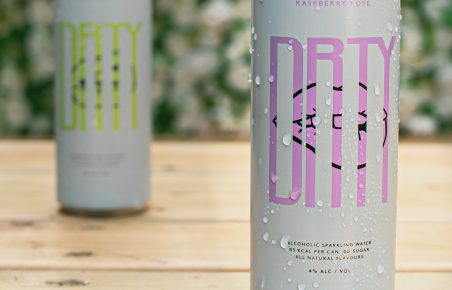
Oli Clements is Director and Co-founder of DRTY Drinks, makers of DRTY Hard Seltzer, which launched in October 2019. With a career in the drinks industry, working in marketing and brand management, he naturally kept an eye on market trends. “Hard Seltzer is THE drink in America. It’s kicked off, because it has a very accessible flavour with zero or low carbs. It appeals to people that want a drink that’s alcoholic and tastes good, but is low in calories. I was in America two years ago and saw a couple of brands there. I thought these were fantastic, refreshing and fun. They weren’t taking themselves too seriously like a lot of the booze industry can do. So, I thought it was a good enough concept and category to finally take the plunge and do it myself. I then worked on it evenings and weekends.”
The DRTY difference
With the category already growing fast, each new brand will need to carve out its own niche. “Our brand is a bit different“, says Oli. “A lot of the other brands are pitching it as healthy booze. So we call the brand DRTY and with that we want to celebrate what we call the “DRTY life”, which is this sort of point of view that doesn’t take itself too seriously. It’s accessible and it’s fun!”
Oli is clear on how to differentiate from the ever-growing competition. “Our flavours are quite different too. They pack a bit more of a punch. Our White Citrus is grapefruit and lime – very tart and zingy. The Raspberry Rosé is more floral.”
The recipe
Unlike other products, there aren’t many rules regarding the category. So, how does DRTY Drinks make its Hard Seltzer? “The whole idea is that you’re mimicking seltzer“, says Oli. “You can make it with vodka or you can make it with a malt base, as long as it’s neutral tasting.”
The company works with a producer in Herefordshire who makes the ethanol from apples. “We chose a fruit wine base as it gives a little fruity edge to it“, explains Oli. “We add a bit more sugar in the fermentation, which means that at the end we don’t get any residual carbs and sugar. The final alcohol that’s created is at 18% ABV with very low to no carb content. We take that liquid and dilute it with water to 4%. Then we blend with sparkling water and natural flavours.”
Natural flavours
Oli is keen to use good quality ingredients. “The natural flavours we work with come from a variety of flavour houses, while the sparkling water is Austrian. We chose Austria, because we work with a canning manufacturer there and they use some really good local spring water. So we thought, why not! It’s very pure.”
DRTY Hard Seltzer is available around the country at selected retailers and online. RRP per 330ml can is between £2.00 and 2.50.
Sence Hard Seltzer
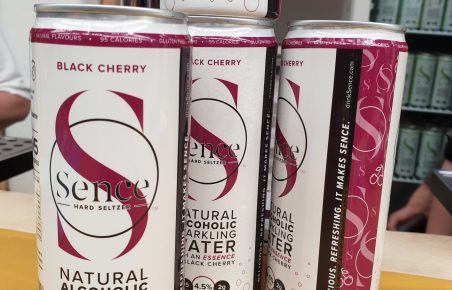
Xavier Warburton, CEO and founder of Sence Hard Seltzer is enthusiastic about this new drinks category hitting the UK shelves and bar scene. “We’ve just launched a delicious, refreshing hard seltzer in the UK market. We’re here at BrewLDN, demonstrating the product in five different flavour profiles – on draught as well as in 330ml Sleek® cans. It’s been really exciting getting to this stage, analysing the competitors’ products on a molecular level and ensuring that we provide the consumer with a better tasting product at the same sort of calorie and carb levels. So, we have Lemon and Lime, Mango, Raspberry, Black Cherry and Pure. These range between 79 and 95 calories, depending on flavour.”
Competition
Xavier is focussed on ensuring that his products retain a strong position within an increasingly competitive market. “It’s no surprise there are other hard seltzer on the market. The competition launched mid-to-end of last year. It’s making great headway and doing very well. We feel that with five different flavour profiles, ours is a very competitive product and so we have a chance of getting a share of the UK market.”
Different markets
Although the US is a much larger market with a different drinking culture, Xavier sees good potential over here too. “It’s really popular in the US, purely because it’s a great alternative to a beer or a vodka soda. The amount of PR around health consciousness in the US is huge, whereas the UK is a much smaller market. We’re initially launching in the UK, but have a good global network that we’re looking to expand into and are developing at the moment.”
Health conscious consumers
It may be difficult to label any alcoholic product as a healthy drink. However, Xavier’s approach recognises Hard Seltzer’s appeal to the more health conscious consumer. “We feel this is a good market to be launching a UK product in, purely to provide the consumer with a healthier alternative. If you look at the obesity levels and the unhealthy eating aspect of the UK market, the consumer is becoming more and more health conscious. So, we’re simply trying to fulfil that demand by providing a drink you can still enjoy much like a beer, but is lower in calories and much lower in carbs (grams of sugar). It’s quite exciting to be launching in the UK. We’ve been soft launching and already sold out of Raspberry and Pure!”
Adding flavour to the no/low category
“The low and no alcohol category is only on the rise“, continues Xavier. “I think providing a great tasting product that is delicious, refreshing and overall tastes great will sell itself. That will probably help develop the category, along with the competition that’s already doing a great job of pushing the sector on.”
Currently, Sence Hard Seltzer can only be purchased online from their website. However, Xavier is confident that his products will soon be available in can or on draught in different venues and retail outlets. RRP is £1.99 per can.
Breweries follow the trend
While new companies are dedicating themselves to only producing Hard Seltzer, others are adding this new category to their existing drinks portfolio. Two breweries that have recently done this are London Fields and Salt Beer Factory.
London Fields Hard Seltzer
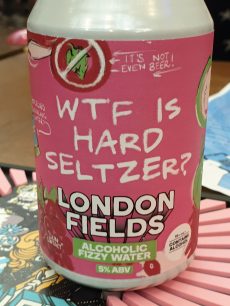
Senior brewer, Kath Stratford, shares her views on how London Fields created a unique Hard Seltzer in time for BrewLDN. “A lot of producers buy in ethanol, but what we did was to create a fermentable product ourselves. So, we basically made a sugar syrup of dextrose and water. We had some Pinot Noir red wine grape skins that our friends at Renegade Urban Winery in Bethnal Green kindly donated to us. So, we put those into our hop dosers and recirculated the sugar water through it, which gives the seltzer a lovely pink colour.”
“We’ve picked up quite a bit of tannins, but it works really well in this. We then fermented our sugar water with Champagne yeast, which ferments every bit of sugar. It’s quite a neutral tasting yeast though, so the wine character you get comes just from the grapes. We then added 100kg of white guava purée to our 1000L batch, which took the colour down to a slightly milkier pink. We centrifuged it to take out any remaining yeast and packaged it this morning, so it’s very fresh!”
The BrewLDN event was the main launch for this new product. Sold in can and keg at the London Fields taproom, once lockdown is over, it should also be available in selected pubs in the Hackney area.
Salt Beer Factory Hard Seltzer
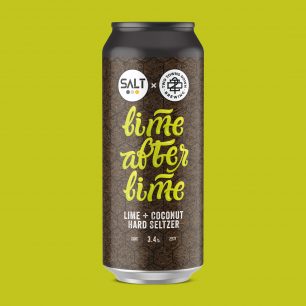
SALT is an award-winning brewery, based in the UNESCO World Heritage village of Saltaire, West Yorkshire. They launched in November 2018 and Ryebeck spoke to company director, Nadir Zairi, to discuss the story of their new venture. “The initial vision of what we’re trying to do is build a really open brand. We want to bring more people into the styles of beer we do. A part of that is being really big on variety. So, hopefully people will recognise a SALT beer and try it regardless of the style. So in our first year, we brewed 47 different styles of beer!”
Hard Seltzer fitted in neatly within this theme of variety, so it was a logical step for Nadir to take. “We wanted to launch it in the summer, so we did our interpretation of the style. We didn’t know what to aim for, but the brief was highly carbonated, really light, zero body and usually infused with fruit. So we took a brewer’s approach to it. Ours is brewed with water, malt, hops and yeast, so the four basic ingredients of a beer. Then we use real fruit and the first [flavour] we did was strawberry, watermelon and fresh mint.”
SALT showcases newest release
At BrewLDN, Nadir showcased their latest release – a lime and coconut flavour – and explained more about how their Hard Seltzer is made. “I think for us, it’s not about chasing a trend, but putting something out there that’s fun, exciting and interesting. The alcohol comes from the grain as it would with any beer. It’s classified as beer, because it is. I think you can get that from tasting it.”
“There’s a very light malt base, which is where the sugar comes from. It’s a Pilsner malt, which is a malted barley and we add torrefied maize. The maize is really light-coloured and it helps with head retention. We use just a very clean yeast, so there are no esters from it. The yeast does its job and creates the alcohol, but there’s no lasting flavour from it. We use a very small amount of bittering hops as well, plus lime zest and coconut flesh. It’s a brewer’s interpretation of a hard seltzer.”
Unlike most other Hard Seltzers of 4-5% ABV, SALT’s is 3.4%, packaged in a 500ml can. “We’re big on sessionable beers“, explains Nadir. “It’s super-refreshing and you can probably drink it quite fast on a hot day. We want to be responsible with the ABV as well. The first one we did was 4%, so still at the low end.”
Impact of the weather
There is certainly general enthusiasm over the increased interest in Hard Seltzer. However, Nadir offers a more sober view on its potential success in the UK, despite the trend in low/no alcohol and low-calorie drinks. “We don’t see it mirroring what’s happening in the States and taking over a huge chunk of the market. I think it has a place for sure, but I just don’t feel it’s going to impact the beer scene as it has done in America. I think genuinely part of it is down to the weather. If you’re in a sunshine state all year round, then Hard Seltzer is great to drink.”
With a growing low and no beer scene in the UK and other innovative alcohol-free products, Hard Seltzer has plenty of competition. Nevertheless, there is always space in the drinks category for new products that shake up the market and give more choice to the consumer. This category is still in its infancy, so there’s plenty of time for new, exciting flavour combinations to emerge. I think it’s safe to say that we can all look forward to a ‘harder’ future!
Other feature reports from BrewLDN can be found on Ryebeck’s Industry Insight pages.
If you are interested in producing Hard Seltzer and need some equipment, give Ryebeck a call on +44 (0) 800 689 3216 or contact them via their online form.
Author: Robin Goldsmith of The Write Taste.
Small beer with a big heart!
The ‘no and low’ beer, wine and spirits category is growing. Expectant mothers and motorists, the health conscious and ‘lifestyle consumers’ in search of lighter styles with fewer calories and lower alcohol have more choice than ever before. It’s a phenomenon that’s hard to ignore. Small is big!
What do low and no alcohol mean?
Out of all alcoholic drinks, beer has undoubtedly been the most successful at reducing ABV. However, there is still confusion in the UK over the terminology used. In the US and most of Europe, ‘alcohol-free’ means a maximum of 0.5% ABV, but in the UK, the legal limit is 0.05%. A ‘Low alcohol’ label in this country then refers to drinks between 0.5% and 1.2% ABV.
Germany has arguably been at the forefront of producing high quality low and no alcohol beer. For a brief snapshot, take a look at this exclusive report for Ryebeck. However, the UK is starting to produce a range to rival the best.
Small Beer
Back in the 1700s, weaker beer of between 0.5% and 2.8% ABV became a viable substitute for unsafe and unpalatable drinking water. Being below the diuretic limit of 3% meant that small beer provided both hydration and nutrition, as well as tasting much better than water! Therefore, people used to brew small beer at home. It was never made in breweries. Improved sanitation meant that small beer eventually fell out of favour, but is it on the way back?
One British company inspired by tradition, that is leading the way in creating delicious, flavourful, low ABV beers is Bermondsey-based Small Beer Brew Co.. Founded in 2017 by Felix James and James Grundy, Small Beer Brew Co. only produces beers of between 0.5% and 2.8% ABV. This makes them the world’s first small beer brewery!
Origins of Small Beer Brew Co.
Felix and James originally met while working for Sipsmith. Felix had already been brewing beer for 14 years with Budweiser and Fullers and also as a home-brewer. James was working in wine and spirits and both shared a love of beer.
“We were going to pubs at the time, living fast-paced lifestyles“, explains Felix “and both had young families. We would go into pubs, wanting to have a nice beer, but constantly feeling frustration. The very best tasting beers in the craft beer market were 5% or 6% and above. We wanted a great tasting beer that didn’t knock us for six! We didn’t set out [to create] a business and then think what could we do, where is there a gap in the market and what’s doing well at the moment. So the whole concept was born out of wanting to make a beer that we could drink ourselves … It’s all about being able to give consumers the options that we were looking for when we first came up with the concept.”
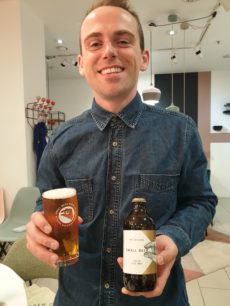
Felix James
A new category of beer
The company currently makes four beers. Apart from the dark lager, which is 1% ABV, the other three are 2.1% (Lager), 2.5% (Session Pale) and 2.7% (Steam). “We don’t really consider ourselves as part of low and no“, says Felix. “Effectively we’re defining a new category – small beer.”
No compromise
With a strong commitment to quality and flavour, they source the best ingredients they can. These include high quality floor-malted barley from renowned specialists Warminster Maltings, together with traditional Saaz hops and US hops for zestier flavours. Having designed a bespoke brewing kit exclusively for the production of their small beer, they mix traditional techniques with new technology. The result is small beer with a big heart!
“We want to make our small beer as flavoursome and as full-bodied as we possibly can“, stresses Felix. “We’re looking to achieve that same mouthfeel and body that you would get from a bigger beer.”
Brewing kit
Felix designed the brewing kit specifically to brew small beer. “We opt for flavour efficiency throughout the brewing process. The brew kit is flexible and allows us lots of ability to get as much flavour from the raw materials as possible, rather than alcoholic strength. It hasn’t been designed in a traditional brewing set-up and we use multi-purpose vessels.”
Pure brewing process
The company does not ferment with a low attenuation yeast or strip back the alcohol post-fermentation. They use a good quality lager yeast. “We knew that technically it was feasible to get to where we wanted to be through good brewing techniques … We just use simple, pure brewing methods. We’re not messing around with the process. We’re simply using the pH, the temperature, the thickness of the mash and the brewing kit that I designed to achieve what we need from the beer. That’s full body, full flavour and a slightly lower level of alcohol.”
The beers are all made without forced carbonation, filtration, pasteurisation or clarification. “It’s effectively tank beer in bottles“, says Felix. All the beers are suitable for vegetarians and vegans. Additionally and unusually, the lager is entirely naturally gluten-free, as enzymes do not need to be added to break down the gluten.
Sustainability
Sustainability is a key part of the brewery’s ethos. “We take sustainability very seriously. We always look at the full life cycle approach for everything that we do. All of our materials, whether that’s our boxes, the labels on the bottles, or our business cards – everything is 100% recycled and 100% recyclable.”
Reducing water usage
They operate sustainable brewing methods, using just 1½ pints of water to produce a pint of beer, instead of the usual 8-10 pints. “Part of the reason that we were so keen to design our own kit was specifically to focus on reducing water usage. The brewery is entirely dry floor. We don’t use water to wash down lots of solids which is typically the case in breweries. We do use water to cool our wort, but only exactly as much as we need for the next brew. After that, we use a glycol chiller. The hot air that it generates heats the brewery and the electrical energy that runs the chiller is 100% renewable. All of the energy that we use at the brewery is from wind, water and solar.”
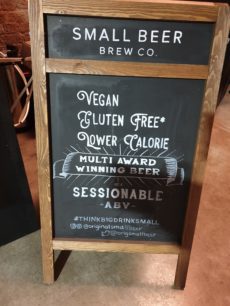
Some benefits of drinking Small Beer!
Unexpected benefits!
The benefits of this approach don’t end there, as Felix adds. “Of the water that’s wasted – half a pint per pint of beer produced – most of that ends up in the spent grain. All of our spent grain goes to a local farm. The farmer has told me that his herd of Dexter cattle drink less from their water trough when they eat our spent grain than when they’re eating dry foods! So even the water that goes to waste isn’t really going to waste as it’s hydrating some cattle!” So happy cows as well as happy beer drinkers!
Where to buy Small Beer
Small Beer Brew Co. beers can be found at Majestic nationwide, Wholefoods and will soon be in Ocado too. All the beers are in bottle, while only the Session Pale is currently available in cans.
Their beers can be enjoyed on draught in pubs, bars, high-end restaurants and hotels, mainly in London but also around the country. They are also available in cultural destinations, including the Royal Festival Hall and National Theatre. As Felix describes, these are places “where you want to go and enjoy a beer before the show and not fall asleep during the performance!”
Events
Small Beer Brew Co. has a large site which doubles up as an events venue which can accommodate up to 200 people. There, they host a variety of events, such as live music, comedy and yoga classes. Additionally, the brewery is available to hire as a venue for corporate days and private events, including weddings and other celebrations.
Ryebeck can provide fermenters and other vessels for all your brewing needs. If interested, feel free to call their helpful team on +44 (0) 800 689 3216 or contact them via the online form.
Author: Robin Goldsmith of The Write Taste.
Kanpai Sake: Peckham on the outside, a taste of Japan inside!
Kanpai Sake prepares for the Rugby World Cup
Kanpai London Craft Sake has launched a special edition just ahead of the Rugby World Cup in Japan, which runs from 20th September to 2nd November. MIRU, which means ‘to see’ in Japanese, is an ultra-premium, Junmai Ginjo Sake. Only 660 bottles have been made with an RRP of £44.95.
Tom Wilson, Co-Founder and Head Brewer said: “MIRU is supposed to be a perfect all-rounder, a crowd pleaser. It’s not too extreme one way or the other – not too sweet, dry, floral, estery nor overly savoury. It has very gentle acidity. This is a sessionable sake and can also pair with a huge array of food.”
Junmai Ginjo Sake
Junmai ginjo is a style of sake in which the rice has had a minimum of 40% of its outer level polished off and no alcohol has been added.
In order to make MIRU, Kanpai incorporates high quality ingredients:-
- Yamada Nishiki rice, a short-grain Japanese rice often used in premium sake due to its large kernels that make polishing easier.
- Foamless 901 Japanese sake yeast.
- A selected traditional Japanese koji (cooked rice inoculated with a fermentation culture that helps break down carbohydrates into sugars).
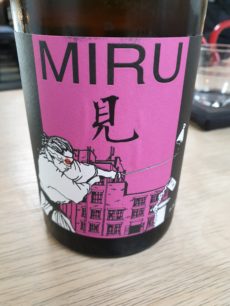
The label, designed by local Peckham illustrator Meroe, shows a blindfolded samurai slicing open a sake carafe in front of Peckham’s iconic Bussey Building!
This is a fruity, smooth, elegant, junmai ginjo sake that manages to combine both intensity and delicate, nuanced stone fruit-like flavours. MIRU will pair particularly well with charcuterie, strong cheeses and shellfish. Serve it either cold or at 40-45°C.
Birth of sake love
Tom and Lucy have quickly established Kanpai as one of London’s most innovative alcohol brands. Tom’s journey began with the discovery of Japanese food and sake while visiting New York as a young man. Moving back to London in his early 20s, he found a huge void in what was available at the time. Having begun home-brewing, Tom and Lucy went to Japan on holiday and visited several small sake brewers. Returning to the UK, they started experimenting and brewing sake for three to four years.
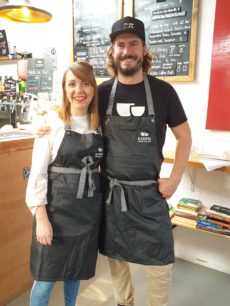
Tom & Lucy Wilson
Success comes quickly
They then set up as a commercial business in Peckham in 2017. Through word of mouth and social media, the quality of their sake became known and attracted the Sake Sommelier at Selfridges. So a short time later the UK’s pioneer sake brewery launched their first product in this prestigious London store. Success continued and so the brewery moved to larger premises down the road last August, before launching the taproom bar in December. “The response from people so far has been overwhelmingly positive“, says Tom. “We have many supporters from the Japanese community in the UK and Europe. People from Italy and Germany even go to London for the weekend, specifically to visit Kanpai!!”
Recognition
Kanpai is one of only five sake breweries outside of Japan, recognised by the Japanese Government. Therefore, they have access to the government’s sake yeast bank, sourcing pure strains of traditional sake yeast. With several accolades, Kanpai is the first non-Japanese sake brewery to win a medal in the International Wine Challenge (IWC) Sake Division, gaining a Bronze for its sparkling FIZU in 2019.
A ‘craft’ approach
Tom and Lucy have taken their inspiration from craft beer and spirits, so are keen to experiment with their styles. With a core range, they also produce limited one-off sakes, varying the ingredients each time. Strict laws in Japan govern what is allowed to be called sake, but Kanpai is all about experimentation and using innovative ingredients. This means they can create a sparkling sake dry-hopped with Mosaic hops or infuse a junmai with watermelon. “We’re in a unique position“, explains Tom. “All of our techniques and processes are based on very traditional methods of making sake and traditional styles. However, we can put a contemporary twist on this and draw from other influences around us.”
Experimentation
For Tom and Lucy, experimentation is crucial to their philosophy. “First and foremost we are an experimental brewery“, adds Tom. “We were born out of the back of experiments. So we like to keep that continuing throughout what we do. We have our core range sakes, we have our limited runs, but for anything to get to that point, they’ve been through at least six rounds of experiments! So for us it’s important to be continually flushing the brewery with new ideas, drawing on other influences from around the world and the alcohol industry.”
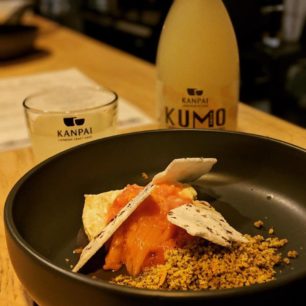
Sake is meant to go with food!
Food matching
Sake’s umami character makes it incredibly versatile with food, not just Japanese cuisine. This is something Tom and Lucy are keen to express throughout their range of sakes. So, they produce fuller bodied flavours to match different types of food, including Sunday roasts and spicy food. “We’re trying to change the hearts and minds of people to maybe trade that bottle of wine for a bottle of sake…It’s meant to be with food!”
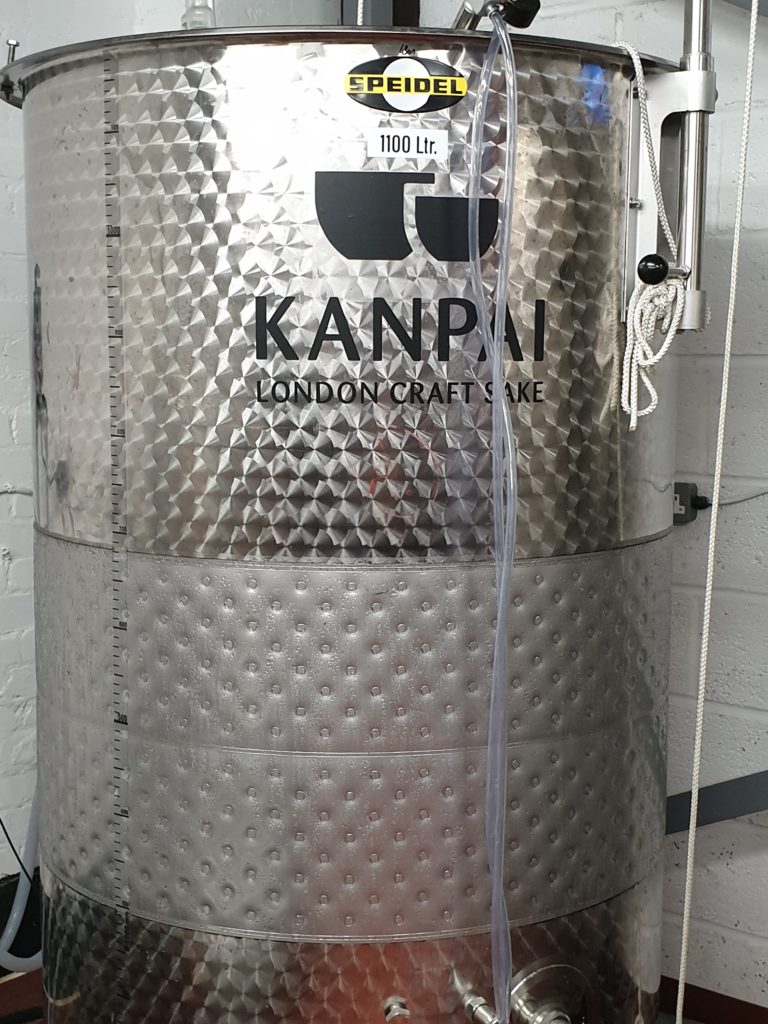
One of the main fermentation tanks at Kanpai Sake. They have two 1100L and two 500L tanks. The press, pasteuriser and steamer were custom-made in the UK.
Fermentation
Unlike craft beer, which typically takes 7-10 days for the primary ferment, Kanpai’s sake takes 45 days or longer at a low temperature. The process begins in a mini stainless steel tank. Tom builds a starter batch of sake, Moto, from all the yeast mixed with small amounts of freshly steamed rice, koji and water. This typically takes about 14 days and is then pitched into the main fermentation tank. Then small amounts of the remaining ingredients are gradually added in stages over a four-day period to propagate the yeast colony. It takes around 10-15 days for the Koji to break down the sugars and start to build alcohol.
Following fermentation, the sake is pressed out in a Fune and typically bottled straight after filtration. Once it’s been sealed and pasteurised, the sake matures in bottle for over three months, before it’s ready for release.
Low intervention styles
All Kanpai sakes are natural, low intervention styles that use traditional Japanese Sake yeast, not hybrid varieties. They are filtered through cotton, not charcoal, to remove sediment, are sulphite-free and vegan, while no fortified spirit is added.
Kanpai’s core range comprises the classic Junmai SUMI, the cloudy Nigori KUMO and the dry-hopped sparkling sake FIZU. These are available through Amathus Drinks, as well as at the brewery, online and in selected restaurants, bars and retail outlets. MIRU will also be distributed by Amathus.
Ryebeck are experts at sourcing fermentation, maturation and storage vessels for all your brewing needs. If you have a question, just give the team a call on +44 (0)800 689 3216 or contact them using the online form.
Author: Robin Goldsmith of The Write Taste.
The best of the best!
There may have been a red carpet, but there were no tearful acceptance speeches and definitely no divas!
The International Brewing & Cider Awards Ceremony is known as ‘The Oscars’ of the beer and cider industry. Rybeck was present to see the medals presented and to hear the 2019 champions being announced for the first time. There was also a unique opportunity to speak to two of the principal organisers.
Oscars of the Beer and Cider World
The International Brewing Awards and International Cider Awards are among the most prestigious of their kind. Judged by industry peers, they highlight the best beers and ciders in the world. They are known for having the highest of standards and are regarded as ‘the awards to win!’ This biannual competition is the oldest beer and cider awards still running in the world, dating back to the late 1880s. The Brewing Awards were first held in 1888. The Cider Awards, beginning 1901, were reintroduced in 2013 after a break during the 1960s.
The 2019 awards ceremony was held on 1st May in London’s Guildhall. Guests had a chance to taste many of the winning beers and ciders. Like the 51 judges from over 20 countries, these also came from all over the world. There were 1000 entries with 66 beer medals awarded to breweries from 21 countries. Additionally, 19 cider medals were awarded to competitors from 11 countries. As Chairman of Judging, Bill Taylor, remarked: “the awards have an international footprint true to their name.”
Origins of the Competition
The competition grew out of the Brewers’ Exhibition, first held in 1879 in London and then held annually for the next 15 years. This exhibition was a showcase for technological innovations in brewing equipment and other drinks machinery. It was here that the brewery competition started. Word then spread through advertising and via people who had already visited. “This competition existed before beer competitions were fashionable“, notes Bill. “It came out of a group of industry people and it’s still run that way. Over time, that created a sense of loyalty, identity and lay the foundations for the future.”
Evolution and Endurance of the Awards
The competition has evolved over its 130 year history to reflect many developments in the global beer and cider market. This year saw more classes and so more medals than ever before. “We try to reflect changes in the marketplace“, explains Bill. “For example, a few years ago we introduced a Special Hopped Beers category. If you visit pubs around the world, you see blackboards advertising beers with hop varietal names. Consumers are speaking that language now. We saw that as a trend and so wanted to provide an opportunity for beers defined by hops. These could be lagers, IPAs or some innovative style that someone’s created. So rather than breaking down into individual styles, we have Special Hopped Beers – beers defined by hops. This is what connects to the consumer.”
The Judges
The raison d’être of the competition is to award excellence in brewing and cider making. This relies on having the best judges. They are all brewery and cider professionals working in commercially operating breweries and cider businesses. They are responsible for bringing beers and ciders to market. Therefore, judges include many head brewers plus production directors, top sensory experts and others. Bill explains further: “We want people who understand how to select ingredients, transform them into a product in the glass and decide what goes to market. Our judges could have 30 years’ experience or be young brewers who’ve made a real impact in their local market doing something different and innovative. They have a mix of experience and diversity helps. Our judges work in a team. It’s the conversation and richness of that conversation that’s important. We need people who can listen more than they can talk.”

Ruth Evans MBE and Bill Taylor
The Judging Process
The judging panel focuses on quality and commercial worth from a professional and market perspective. They do not just rely on written style definitions. Judging is carried out through discussion rather than using a points system. Categories are broken down into classes defined primarily by ABV. This format clearly works, as the competition’s reputation has endured for so long. “We don’t try to categorise everything“, adds Bill. “We give judges permission to recognise excellence when they see it. For innovation, we’re providing opportunities that are somewhat unique. A controversial beer has to be talked through from a professional level. The pros and cons are discussed until a consensus can be met. Judges have to own their decisions and be prepared to talk about and justify them. It’s their reputation that’s on the line.”
Another unique feature of the competition is that judges also decide the colour of the medals awarded. Thus a Gold, Silver and Bronze are not guaranteed for every class or category. This would usually affect categories with a smaller number of entries. For example, the new class of Zero Gluten Beer received fewer entries than the Gluten Free one. Consequently, this year the judges agreed to award a Silver medal only for Zero Gluten and a Gold and Silver for Gluten Free.
Reputation, Relevance and Prestige
It’s not easy to win an award at this competition, which is part of the reason why they are so well regarded. “Our awards are known as the Oscars“, says Chief Executive of the Awards, Ruth Evans MBE. “They are peer reviewed and very well regarded, celebrating excellence. The big difference with our competition is that it’s run by the industry for the industry on a not-for-profit basis. When beer is not quite so popular, our awards will still be going!”

Trophy winners celebrate their win outside London’s Guildhall
Championship Winners Trophies
Beer Trophy Winners
The awards ceremony also revealed the Trophy winners, recognising just nine beers and three ciders as outstanding examples in their respective categories. Judges sit in silence and are presented with the Gold medal winners. They then vote in a secret ballot for the beers and ciders that they think are the ‘best of the best’ in a marketplace context. As Ruth describes, these are the products that “the judges would be prepared to stake their future success on.” All beers and ciders are tasted blind in the competition and the championship winners have been tasted at least three times.
Winning a trophy at the Oscars of the beer and cider world is hugely significant for breweries and cider companies. It represents recognition of the high quality of their products from industry peers and professionals. As Bill remarks, “there can only be one best picture, so there can only be one gold medal. We ask the judges to pick the best – that’s what we’re looking for. It’s a career-defining moment!”
Changes Reflect the Market
The competition has evolved over time to reflect the state of the market. Changes have already seen new categories, including non/low alcohol beers and gluten-free, for example. Although these may represent a niche area, “they need to be recognised and their excellence rewarded“, according to Bill. Interest from brewers is growing too. “Low and no alcohol beer certainly grew as a category this year with double the number of entries from the last time“, confirms Ruth. “We’re seeing a more sophisticated and stylistic approach to these now”, adds Bill. “The consumer is responding more favourably.”
Growth in Beer and Cider Classes
Since their reintroduction into the competition, the number of cider classes has grown every two years and is set to continue in this way. “We’re trying to grow the cider competition“, explains Bill, “but you can only grow at a certain rate. You have to earn the trust and involvement of the industry and re-own it. Unlike beer, the competition had not been involved with cider for a number of decades.”
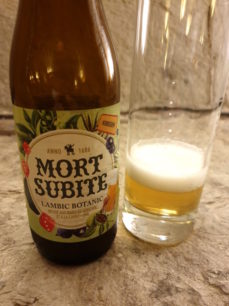
Alken-Maes Mort Subite Botanic Lambic – one of the Gold Medal winners
Similarly, the number of beer classes is also likely to grow. This reflects the increased interest in beer among consumers, particularly for new styles and flavours. Both Ruth and Bill see the future of beer as very positive. They note that it’s becoming more of a gastronomic drink, reflected by the rise of gastropubs and craft beer bars. “It’s not simply an alcoholic drink“, notes Bill. “Younger generations are showing a greater interest in drinking more moderately but with more flavour.”
The Future
The International Brewing & Cider Awards celebrate and reward the best of the global beer and cider industry. They also show a confident outlook for the future of these drinks in a world beset with economic uncertainty. Although Brexit is clearly a serious worry for many in the drinks industry, Bill offers some welcome light relief. “If people worry, they’ll go to the pub and have a beer or cider. If people are happy, something good happens and they want to celebrate, they’ll go to the pub and have a beer or cider!” Let’s all hope that as many of these beers and ciders as possible will soon be available to consumers throughout the UK.
Author – Robin Goldsmith
WSTA calls on Government to end harmful Bourbon tariffs
The Wine and Spirit Trade Association (WSTA) has submitted a response to the Government’s consultation on damaging US tariffs. They have called for the swift removal of tariffs on US whiskies. They also warned that adding duties to wine could be detrimental to UK jobs across the industry.
Decline in trade
Since June 2018, Bourbon and US whiskies have been subject to an additional tariff of 25%. This ended 25 years of tariff-free trade in whiskies between the UK and the US. The decision to impose a tariff on US whiskies, initially taken by the EU, has had a massive impact on our wine and spirit industry. It has resulted in huge declines in trade with our most significant trade partner.
The annual value of US whiskey imports to the UK has halved since 2017. Also, UK importers and Bourbon fans, along with the broader hospitality sector, have paid an extra £55m in retaliatory tariffs, since duties came into effect. Continuation of tariffs either on US whiskies or new ones on US wines could see the US return to targeting UK exports in future trade disputes.
WSTA supports removal of tariffs
The WSTA is calling for a return to the historic ‘zero for zero’ trade agreement between the US and EU that began in the mid-90s. As a result, US alcoholic beverages would also be removed from the scope of all current and future disputes.
Miles Beale, Chief Executive of the Wine and Spirit Trade Association, comments further. “US whiskies have paid more than their fair share of tariffs. In a year when the hospitality industry has seen significant closures, it’s time we got back to trade and not tariffs with our close friends across the pond. The WSTA supports the removal of these tariffs with immediate effect.”
For further news on the spirits industry, check out Ryebeck’s Industry Insights pages.
Author: Robin Goldsmith of The Write Taste
Dima’s Ukrainian Vodka: a quality choice!
Heard of Ukrainian vodka? Well thanks to Dima Deinega, you may already have! He’s a man on a mission to tell as many people as he can just how great premium vodka can be and to banish misconceptions about the category. Dima is a passionate advocate of the spirit. Born in Kiev, but raised in London, he was regularly flying to Ukraine to see family there … before COVID travel restrictions struck. So, while looking forward to future visits when able to do so, he can take stock of his achievements and plan for the future.
Vodka’s growth
DBMR Insights research predicts vodka, as a category, will grow by 6.2% globally in the next seven years. Increasing demand for premium vodkas is one of the main drivers for this, as well as the growing cocktail culture. The US remains a key market for the spirit. In global comparison, most revenue is generated there (Statista). Here in the UK, Smirnoff is the second-most popular alcohol brand behind Baileys and the most famous (YouGov).

Zhytomyr Distillery: the architecture is typical of a smart building from the late 19th century
Dima’s Ukrainian Vodka
Dima Deinega founded Dima’s Vodka in 2020 to introduce a superior Ukrainian vodka to the UK market. It’s a triple grain vodka produced using organically-farmed rye, wheat and barley. The grains grow in chernozem. This is the country’s uniquely fertile, nutrient-rich black ‘super soil’. It offers the very finest conditions for crops.
The recipe was painstakingly perfected in the 125-year-old Zhytomyr distillery on the outskirts of Kyiv (Kiev). It took 38 different flavour combinations and trials by the most experienced and knowledgeable Ukrainian distillers before deciding on the final product. The resultant vodka has a rich and rounded flavour profile with crystal-clear clarity and velvety smoothness that is often not found in other vodkas. It’s also just 58.5 calories per unit of alcohol.
Awards for Dima’s Vodka
In 2020, Dima’s Vodka and Dima’s Vodka Tonic both won Silver in The International Wine & Spirit Competition (IWSC). In 2021, Dima’s Vodka won a Silver for Multi-Ingredient Premium Vodka in the International Spirits Challenge. It also scooped a Gold Medal as Country Winner and a Silver for Design at this year’s World Vodka Awards.
Inspiration
Ukraine is one of the world’s biggest producers of vodka. Also Dima’s father is the founder and owner of the oldest pub in the country. So, Dima himself was heavily influenced by the drinking culture there. Seeing that knowledge and traditions of Ukrainian vodka had not carried over much into the western world, the idea for his business was born. Then a few months after creating his vodka, he launched it in the UK in March 2020.
“The biggest thing I want to do“, he says, “is to show Ukraine in a positive light. The country’s been through a tricky couple of decades. It has an incredibly rich history, culture and traditions. Brands solely built for commercial purpose get lost. So for me, it was always a passion project. I want to showcase exactly where I come from, where I feel very close to and where my family still lives.”

Famous Pechersk Lavra Monastery in Kiev, Ukraine
The bottle
The bottle has an understated, yet classy look and feel, that hark back to Ukrainian culture and traditions. The colours of the Ukrainian flag are represented. There’s blue for sky and yellow for wheat/agriculture, along with Cyrillic-style lettering. The brand logo displays a modern version of the Tryzub (Trident). This is the national coat of arms of Ukraine, showing Dima’s respect for the country’s proud history. Also, the square shape is practical for storage. The long neck means that you can reuse the bottle as an olive oil pourer, for example.
Countering misconceptions about vodka
Dima is undeniably proud of his Ukrainian background. “I always wanted to do something linked to my roots and heritage“, he explains. “I wanted to make a flavourful, but smooth vodka. Most of the time, it either goes into the flavoured category or into the very pure category with no flavour. The balance is a tricky one. It never made sense to me for vodka to be tasteless. That just gives it a terrible reputation with memories of terrible hangovers drinking warm, horrendous vodka at university! The mixers were terrible as well, but people do have these preconceptions. What we’re trying to do now is educate and re-educate people. You can have vodka on its own. You can sip it and enjoy it. It’s not just something to provide alcohol content to a cocktail. It’s there in its own right.”

Wheat fields on fertile Chernozem soil
Budmo!
Vodka plays a huge role in Ukrainian drinking culture and toasting, most significantly, the practice of Budmo! Meaning ‘let us be’, this tradition sees 13 vodka toasts made between families and friends during long nights! These celebrate friends, family, love, health, happiness and anything else!
Vodka styles and flavours
Potato vodka is often perceived as a more luxury product with a creamy, smooth taste. However, the number of potato-based vodkas on the market today is very small and there are many high quality alternatives. Any combination of sugar and yeast can produce vodka. These include grapes, rice, molasses, corn, grass or even milk. This makes it an intriguing and varied category. Most vodka is now made from grains, such as wheat, rye, barley or a combination of them. The gluten is removed during distillation.
Dima’s Vodka: it’s all about flavour and balance!
Every vodka tastes different with a distinctive variation of aromas and flavours coming through. Corn-based vodka, for example, has a sweetness to it. Wheat-based vodka tends to be drier. A grain-based vodka like Dima’s has different characteristics. There’s pepper, aniseed and lemon zest from the wheat, sweet nutty notes from the rye and bready notes from the barley. Other vodkas can have vanilla, spicy and earthy notes, depending on how they are distilled.
Dima specifically chose to make a grain vodka rather than using potatoes. His aim is to highlight perfect balanced flavours from all three grains. “Potato is nice”, he says, “but it has a very specific flavour. With this, you can get so many different options and ways to serve. Also, it’s showcasing exactly what Ukraine is famous for. The main proof is in the taste. Once people try it, they see layers of complexity, smoothness and flavour they didn’t expect. That’s where vodka now is going. Flavour in itself is becoming way more important now.”
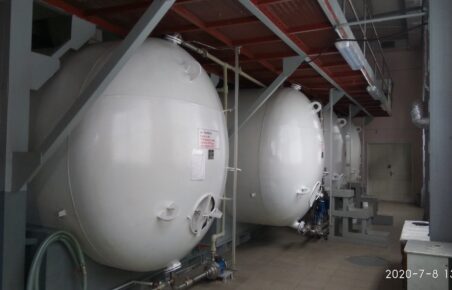
Inside Zhytomyr Distillery where Dima’s Vodka is made
Distillation
The process uses several 700L column stills for three distillations. The spirit is then filtered through sand to remove impurities and charcoal to soften any harsh flavours and mouthfeel. It’s then rested for a week to allow the complex flavours to settle and integrate before bottling.
How best to enjoy Dima’s Vodka
Dima’s Vodka delivers nutty, rye aromas with a hint of aniseed. These continue on the surprisingly smooth palate with an edge of sweet vanilla creaminess and a light touch of spice. The rye flavour builds, brought out more perhaps by the nuttiness of the barley. This makes the vodka a particularly good pairing with the briny, tangy snacking pickles Dima recommends.
As with most spirits, the main flavour profile can be gauged best at room temperature. Vodka changes viscosity when served ice cold which contracts the flavour profile. This means it is sometimes ‘easier’ to drink a poorer quality vodka straight from the freezer. However, many premium vodkas are intended to be enjoyed at room temperature. This is where the complexity of their flavour profile is most present. “People are becoming increasingly open to having vodka and other spirits at ambient temperature“, says Dima, “even if it does mean battling their unpleasant university memories!”
Getting in a pickle!
The conventional way to experience vodka in Western Europe and the USA is as part of a mixed cocktail. However in Eastern Europe, vodka is enjoyed predominantly as a sipping drink. In Ukraine, vodka is traditionally served neat in a stemmed shot glass with pickles.
If you have the pickle before a sip of vodka, it adds salinity. If you eat it after, it helps to cut through the sharpness of the ethanol. However, this vodka is smooth enough not to leave an alcohol burn anyway!
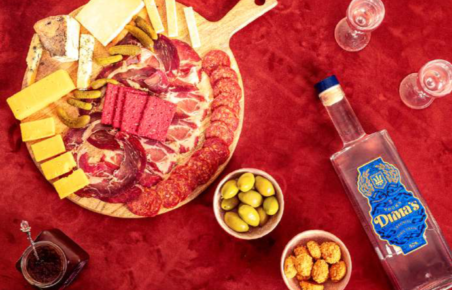
Pairing food with Dima’s Vodka
Other food combinations
Vodka is a really versatile spirit for food pairings. Charcuterie boards are often served with sipping vodka in Ukraine as part of a tapas-style, pre-dinner appetiser. The fattiness of the meat not only lines the stomach. It also softens the vodka to create a well-balanced easy-drinking flavour combination. Dima recommends award-winning Capreolus Fine Foods of West Dorset, for the perfect meat combo.
Dima’s Vodka goes very well too with a creamy cheese, or even a cheesecake. So, it’s a great palate-cleansing alternative to a dessert wine at the end of a meal … and for a deliciously dangerous picnic, how about rye bread, oatcakes, cheese, pickles, charcuterie, olives and Dima’s vodka. Mmm!
Cocktails
Dima is partnering with The Pickle House for a ready-made pickle juice. This fabulous ingredient works really well in so many cocktails. “It adds such a complex layer of salinity that you can’t really get from anything else“, he explains. “Pickle juice really gets across the salty, umami flavours.”
You’ll soon be able to buy a bottle of Dima’s Vodka with a pack of pickles and a bottle of Pickle House Juice for £40.
He’s also entered into a partnership with London’s famous Gibson Bar. They will be making small bottled cocktails using Dima’s Vodka and their own in-house pickle. These include a Pickled Gimlet, Espresso Martini, Sea Buckthorn Cosmopolitan and Fig Martini, all made with Marian Beke’s visionary touch.
Plans for the future
Dima says he has big plans to expand into the US and Europe. However, at the moment he’s concentrating solely on the UK to establish the brand. Future ideas also include potentially producing other vodkas made from single grains with individual flavour profiles.
In the meantime, you can buy Dima’s Vodka online from their website with a packet of Serious Pig seriously moreish snacking pickles included. A 70cl bottle costs £35, while a case of six is £180. Additionally, a Gift Set (20cl bottle, shot glass, cocktail recipes and pickles) is only £25. Budmo!
For more articles on spirits, check out Ryebeck’s Industry Insights.
Author: Robin Goldsmith of The Write Taste.
English Whisky: an emerging category and one to watch!
By 2022, whisky is predicted to be a £2.4 billion market in the UK. As Ryebeck previously reported, there are a number of new trends. These include the way whisky is produced, sold and used in cocktails, as well as where it’s made. A modern generation of whisky drinkers is emerging. So, anyone structuring a whisky list should take account of these developments.
About ten years ago, Scotland, Ireland and the USA dominated whisky production. Now it’s made all over the world. Japanese whisky is a huge success story, winning regular prizes in international competitions. So, where’s the next challenge to the traditional dominance of Single Malt Scotch coming from? Could it be somewhere much closer to home?
Hotel, Restaurant and Catering Show
At last year’s Hotel, Restaurant and Catering Show, Chris Bolton of The Whisky Exchange, spoke about the rise of English whisky. Demonstrating three very different styles, he gave us a welcome taste of developments in this young industry. “In many ways“, says Chris, “we have the Japanese to thank for the concept of new world whisky. It’s a booming industry and a very exciting time.”
Ability to innovate
Scotch is heavily regulated. The Scotch Whisky Association (SWA) is responsible for lobbying the EU and protecting the terminology “Scotch Whisky”. It has to be distilled, aged and bottled in Scotland with strict rules on production giving protection against counterfeit versions. In contrast, the much younger English whisky movement “can go offbeat, innovate, try new things and experiment“, explains Chris.
Spirit of Yorkshire Distillery
Spirit of Yorkshire Distillery is one of the newest distilleries in the UK. It was founded by two farmers who owned the Wold Top Brewery in Yorkshire. Being brewers and farmers, they are able to control the entire process of whisky production from field to bottle. So, they use barley grown on their family farm in Hunmanby to first produce a beer. Then they transport it down the road to the distillery.
The company started to make whisky in 2016 and Filey Bay Single Malt Whiskey is the first release. It’s 46% ABV, so stronger than a standard whisky. As a result, there’s good depth and flavour with citrus notes, a touch of vanilla and light caramel. This is a fresh, vibrant whisky with plenty of character. It would be ideal as an apéritif, perhaps in a highball.
Bimber Distillery
Dariusz Plazewski, a third-generation distiller from Poland, founded West London’s Bimber Distillery in Europe’s largest industrial estate. Bimber means moonshine and Dariusz is passionate about the ‘craft’ movement. He sources barley from a farm in Hampshire and uses traditional methods of whisky making, such as floor-malted barley.
The distillery is one of the only ones in the UK to have direct-firing stills, rather than steam-coil heated stills. They also have their own on-site cooperage. This gives them full control over the type, specification and quality of barrels.
Chris is full of praise for Bimber’s traditional methods. “Nowadays, with the growing pressure and the corporate world of the whisky industry, profits and yield take precedence over that hand touch and influence on whisky making. So, it’s really refreshing to see a distillery going back to a traditional way of making whisky.”
Bimber Distillery ages the Single Malt London Whisky in re-charred oak casks. This gives it a darker colour and richer, toasty vanilla character with a touch of sweetness. The whisky would be great, paired at the end of a meal, with some dark chocolate or even a chocolate-based dessert.
The English Whisky Company
The English Whisky Company, based in Norfolk, was the first English whisky distillery for over 120 years when it launched in 2006. As Chris describes, “this was a landmark moment for whisky making.”
Towards the end of the 19th century, only about four distilleries existed in England. In the early 2000s, whisky started to become more fashionable again. So, the time was right for Lincolnshire farmer and businessman, James Nelstrop and his son Andrew to follow their passion. Using locally-sourced Norfolk barley and fresh water from the Brecklands Aquifer, which runs beneath the distillery, they created an artisan company that’s sparked the rebirth of a little-known spirit category. “The English Whisky Company has been banging the drum for English whisky as a category for a long time now“, says Chris.
The English Smokey is an unmistakeably peated whisky. It has a bonfire smoke character bolstered by spice, vanilla and a very long finish. This is another great example of a whisky to sip at the end of a meal.
The future
English whisky is on the rise. The number of distilleries may still be small at around 24, but it’s growing. Award-winning companies, such as The Lakes Distillery and Cotswolds Distillery, are gaining many new fans. Other craft gin distilleries are now making different spirits too. So, we can expect to see more English whisky coming on to the market in the near future.
If you’re interested in purchasing distillation equipment to make whisky or any other spirit, then give Ryebeck a call. You can reach the team on +44 (0) 800 689 3216 or contact them via their online form.
This is the second of two articles reporting on last year’s Hotel, Restaurant and Catering Show. You can find the first on ‘Low and No’ trends here.
Author: Robin Goldsmith of The Write Taste.
Ryebeck installs new handmade copper spirit still in Denmark
Brinksgaard is a lifestyle shop, 12km from the North Sea and even closer to the German border. Attached is a small café from which Hans Sjursen and his wife sell around 55 different gins and 45 rums. They had also bought an old fire truck to use for corporate and private events, kitting it out with draught beer dispensers. This led Hans to consider making alcohol himself and so Marsk Distillery was born.
The idea for a distillery is born
Hans began experimenting with distillation about 18 months ago, using a small 10L copper still. Pleased with the results, he decided to move things forward and make spirits commercially. So last October/November, he contacted Ryebeck.

Truck with draught beer dispensers used for events
Contacting Ryebeck for a spirit still
Hans was very impressed by the speed at which Ryebeck responded and the service he received. “I contacted Tim [Tim Prime, Managing Director] and he called me back quickly. We had a very good talk.”
Having spoken to several companies, he preferred Ryebeck’s personal approach, quick responses and helpful attitude. Rather than assuming that, with little experience of distilling, he would buy any equipment, they took the time to understand his situation. They were then able to recommend the type of still that suited him and to provide extra support.
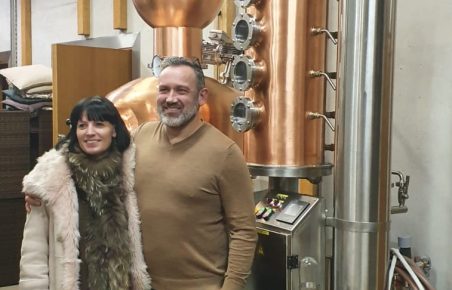
Hans & his wife standing in front of the Ryebeck-installed spirit still
Choosing a spirit still
In January this year, Ryebeck took Hans to see a 250L copper spirit still they had installed in Slovenia. He was so impressed by what he saw, that he decided to buy the same model. Ryebeck delivered it around Easter and Hans has named it Berta. The size fits easily within the building and complies fully with Danish legal requirements for a small distillery.
Hans is particularly full of praise for how good the still looks in his relatively small setting. “We have to do something that’s different and with charm, given that we’re not a big distillery. It looks handmade and when people come here, they say it looks like art! Also the copper ensures that our distillate has a smooth taste.”
Ryebeck to provide extra support
The Ryebeck team agreed that he needed some help to get started and arranged for master distiller Craig Law to provide that service. Unfortunately, due to COVID, he has so far been unable to spend a week at the distillery. “Now we’re learning by doing and waiting for him“, says Hans.
Local inspirations
Hans creates the base spirit himself from imported sugar. He then uses this to make seven types of gin and two rums, including a sweet rum. All bottling is done on-site.
For one of his gins, Hans uses a local ingredient, dunhammer or cattail, which grows by a nearby lake. This creates a unique taste profile. “There are thousands of gins in the world, but nobody has tried this before“, he explains with passion. “It tastes mainly like cucumber, but the aftertaste is a bit like wild asparagus. So it’s good with the local seafood.”
He also uses chamomile, which grows locally and is currently planning to plant juniper bushes.
Additionally, he has just made a Christmas gin with apple juice, to be drunk hot. After great feedback, he’ll be making more!

Sales
Hans sells his spirits from the Brinksgaard shop and also in local lifestyle and independent wine stores. Being so new, he’s not yet running at full capacity, but his reputation is growing. In September and October, he sold around 1000 bottles of gin and is already looking for other stockists around Europe. “We’re a very small distillery. We don’t make a lot, but our taste is unique!”
Future plans
Denmark has a vibrant drinks scene with beer particularly big. “Many people don’t drink gin, as 20 years ago, they only had the cheap ones. They drank too much and it tasted of pine! There’s a door open for gin now, as people find out that the new gins taste great.”
Hans has plans to make more products in future, but is not going to rush in too early. “At the moment, I’m learning to crawl. Then I’ll learn to walk. When I can walk, perhaps I’ll look at making whisky or something else. For now, I’ll specialise in rum and gin.”
The Ryebeck experience
As well as making spirits, he now has three vehicles to use for corporate events, supplying beer, rum and gin. None of this would have been possible without his passion, energy and vision, but also the equipment sourced from Ryebeck. He particularly values their continuing relationship and can recommend them to anyone in a similar situation. “I get help from them via WhatsApp and emails. If I have a problem, I can call them too. They are very professional. You can trust them and they deliver what they say they will. It’s been a very good relationship.”
Author: Robin Goldsmith of The Write Taste.
The impact of lockdown on beer enthusiasts!
Lockdown has affected all of us in different ways. However, its impact on the drinks industry, particularly pubs and breweries, has been profound. Many companies have made radical changes to safeguard their businesses and sell their products. Online and direct-to-customer sales are up and, in some cases, represent brand new revenue streams.
In contrast, on-trade sales of beers, wines and spirits suffered while pubs, bars and restaurants closed their doors. So, what does the future hold for beer drinkers, used to visiting their local pub or trying out a new venue whenever they want? Has lockdown had a permanent effect on how we buy beer and where we drink it? This is the subject of a report commissioned by Brew//LDN and conducted by KAM Media, research and insights experts for the hospitality sector.
New survey on beer enthusiasts
Brew//LDN’s inaugural event took place from 27th to 29th February this year prior to lockdown. The festival attracted around 12,000 beer consumers, enthusiasts and trade professionals. From these, 2,519 Brew//LDN registered subscribers completed an online survey for the new research. Participants were defined as ‘beer enthusiasts’, i.e. those who regularly consume and view beer as a hobby, as well as just a drink. KAM Media carried out the research between 29th June and 6th July.
How lockdown has impacted beer consumption
Volumes of beer
Beer enthusiasts have been drinking more often, but in lower quantities as a result of lockdown. The research shows that the number of people drinking beer six or seven times a week increased from 5% before lockdown to 19% during this period. The average number of beers per session, however, decreased by 9%.
Experimenting with new beer styles
More people are experimenting with different styles and alcoholic strengths of beer. There was an increase in the consumption of ‘premium’ beers, with 47% drinkers saying they are drinking more of these. Additionally, 24% of drinkers switched to higher alcohol beers, while 17% opted for low ABVs. IPAs have seen the biggest increase in consumption. In fact, 28% of people say they are drinking more IPAs, compared to 21% for pale ales and lagers.
The appeal of trying new beer styles is even more extensive. Indeed, 57% of survey respondents indicated they are more interested in searching out unique beers since lockdown. Also, 79% of people said that they were more attracted to supporting local breweries now.
So, people are changing how often they drink beer, the amount and styles they choose and where the beer comes from.
How lockdown has impacted beer purchasing
Brewery on-line sales
Buying beer online has proved very popular. In fact, 65% of people have purchased more beer online, direct from breweries. Of these, three quarters have done so for the first time. Importantly, 86% indicated that they would continue post-lockdown.
Orders from specialist websites
Also, more drinkers have ordered from beer specialist and subscription websites and will do so again. These include the 21% who have never signed up for beer subscription boxes before. The main reason for this, according to 70% of respondents, was to try new beers.
Purchases from physical breweries and taprooms
In addition, 31% of survey respondents have purchased beer from physical breweries and taprooms more since lockdown began. Over half of these have done so for the first time and nearly 90% of these will continue.
All of this implies a greater willingness to support local breweries and try new beer styles, whether ordering online or at physical venues.
Home help from local breweries
Although not contained within KAM Media’s report, it’s worth noting how breweries quickly adapted to the coronavirus pandemic, helping their local communities. For example, Black Sheep Brewery started a home delivery food service for the first time. This ‘new way of working’ clearly benefits local people. It can also add an extra revenue stream to help keep businesses solvent and hopefully avoid or reduce potential redundancies.
How beer drinking occasions have changed
One of the big attractions for many drinkers during lockdown has been the availability of online events. Many of these have been educational and/or promotional campaigns, as well as social. However, with more people using online meeting platforms, socialising with friends from home with a beer in hand has really taken off!
Online socialising with beer
Just under eight out of every ten people have been drinking beer with friends online during lockdown. Half of these said that they would not stop once pubs reopen.
Outdoor meetings
Additionally, over 50% have been meeting friends in the park and having a beer together. Out of these, 83% intend to continue. It’s surely no coincidence that almost 60% of people have purchased takeaway beer from a brewery or pub. What better way to enjoy your pint of beer on a warm summer’s day or evening than by sharing with friends outdoors!
So, online hangouts and outdoor drinking with friends during summer have presented new opportunities for breweries to engage with beer enthusiasts.
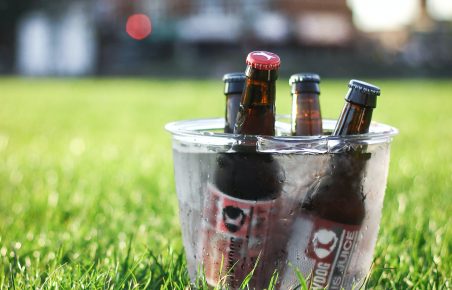
Beer in the park
The future of pubs
Now that most pubs have reopened, will people continue to visit them as much as before? According to this survey, 31% said they would be going to pubs and bars less often. This represents a projected 5% net decline in pub and bar visits.
In contrast, 47% said that they would be visiting taprooms more, a net increase of 32%. Similarly, 48% said that they would be visiting independent beer shops more, a net increase of 40%.
The interest in supporting local breweries would seem to be having a knock-on effect on the popularity of taproom visits. So, if pubs want to continue attracting customers, they may need to change their offerings to include extra local beers. Also, beer enthusiasts’ keenness to experiment with different styles suggests that pubs could benefit from diversifying their range of beers.
A note of caution
Although lockdown has had some positive effects on beer sales, the negative repercussions for the hospitality industry remain very serious. A recent report in The Drinks Business highlighted findings by the British Beer and Pub Association (BBPA) that a quarter of UK pubs could go out of business by next April. Reduced capacity, due to social distancing measures with decreased footfall and lower consumer confidence, is having a severe effect. A reduction in beer duty and business rates could, therefore, also be vital for pubs to continue trading.
Overall conclusions
It would appear that lockdown has encouraged people to try new beer styles from the comfort of their homes. These include more unusual, interesting or local beers and also different ABV levels. While pubs were closed and with supermarket beer choices not always preferred, beer enthusiasts changed their buying and drinking habits. Breweries also had to readdress their own business models in order to survive and reach new audiences. Online hangouts and ‘beers in the park’ replaced pub visits, the latter a popular option during the warmer summer weather. These new trends will likely drive beer retailers, breweries and pubs to reconsider what and how they sell in the future.
However, even if consumer confidence rises significantly, government intervention will still, more than likely, be required. This may help prevent pubs closing permanently with the knock-on effects for the whole beer industry. Nevertheless, recent spikes in COVID-19 outbreaks, enforced earlier closing times, threats of another national lockdown and consequent restrictions on group gatherings will have continuing implications. Therefore, despite some positive signs, the future for breweries, pubs and beer enthusiasts remains full of uncertainty.
You can read more beer articles, including features on the inaugural Brew/LDN event, on Ryebeck’s Industry Insights pages.
Author: Robin Goldsmith of The Write Taste.
The rum category: celebrating our love of the sugar cane spirit!
“Rum’s the next big thing!” is something we’ve probably all heard. Its popularity is certainly on the up, but is the sugar-cane spirit due to eclipse gin any time soon?
Growth of the rum category
Ryebeck’s master distiller Craig Law sees growing interest in the category from all around the world and many distilleries are getting in on the act. “It’s a natural course that even existing distilleries are expanding into“, he says. “There are some very exciting times ahead with rum.”
“If you take gin as a product“, continues Craig, “the bubble has still not burst. However, rum is pretty much on a par with bottles consumed and sales. So if rum is the next big thing, what’s going to happen in terms of sales and products that come to the market? If you look at the huge revenue gin has created, will this be the same for rum?”
Versatility of rum
Craig sees the spirit as particularly versatile and one that can appeal to everyone. “Rum is fantastic“, he explains, “because there’s a style for everybody. So, if you’re a vodka drinker, there’s a rum for you. If you’re a whisky drinker, there’s definitely a rum for you, whether that’s a golden rum right through to a heavy rum. If you’re somebody who likes a product that’s particularly sweet, there’s a spiced rum out there for you. It’s the same with gin drinkers. One of the things we’re currently seeing is the use of botanicals in rum. They’ve always been present in spiced rum and people are now following the practice of making gin to produce a spiced rum style. So there’s definitely a drink for everybody within the rum category.”
The Daiquiri: a celebration of rum!
It’s therefore no surprise that several days in the calendar are now dedicated to the joy of rum. For example, the 16th August saw International Rum Day, following swiftly on the heels of National Daiquiri Day celebrated the previous month on 19th July. So how did that iconic, joyful cocktail, the Daiquiri, come about?
Early history of the Daiquiri
In the late 18th century, sailors from the Royal Navy used to drink grog to prevent scurvy during Caribbean voyages. This was a mix of rum, water, sugar and lemon or lime juice, so not dissimilar to what we know today as a Daiquiri.
However, the original Daiquiri was invented during the Spanish-American War in the late 1890s, in the small mining town of Daiquiri near Santiago de Cuba. Jennings Cox, a Cuban mining engineer and his colleagues would have a drink after work in the local bar. One day, Cox came up with the idea of mixing lime juice, sugar and rum over ice, after he’d exhausted his gin supply. The drink quickly became a local favourite, especially during the hot summer months.
Rum and Daiquiri’s popularity spread
Then in 1909, a retired US Navy officer tried the ‘Daiquiri’. Liking it so much, he took the recipe back home to Washington D.C. and it soon became a well-loved drink, spreading to New York clubs too. During the Prohibition Era in the 1920s and 1930s, rum was smuggled into the US and was Cuba’s biggest export. Then, when whiskey and vodka were rationed in World War Two, rum’s popularity soared.
The Hemingway Daiquiri
The Daiquiri became a favourite drink of Ernest Hemingway and President John F Kennedy. Indeed, it was in a Havana cocktail bar, El Floridita, that writer Ernest Hemingway picked up a Daiquiri, tasted it and then asked for it to be made with less sugar and more rum. The ‘Papa Doble’ or ‘Hemingway Daiquiri’ was born, although it was changed to make it more palatable, with the addition of maraschino liqueur and no sugar!
Don Papa Rum
Don Papa, a premium aged, single-island rum from the Philippines, is sold around the world and is perfect for making a Daiquiri. Volume sales in 2019 reached 2 million bottles and the brand is particularly successful in Britain. UK Marketing Manager, Cristhel Molina, explains further: “We are currently in 28 countries spread across Asia, Europe, North America, Central America, and South Africa. However, we feel that the UK offers potential as we’ve seen great interest for Don Papa Rum. Consumers are willing to explore rums from different parts of the world.”
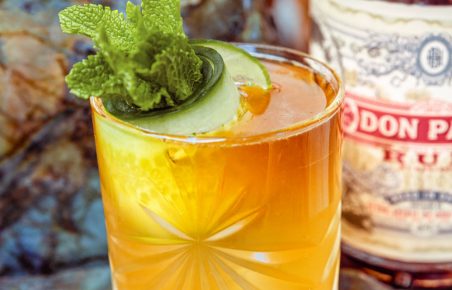
A ‘Manila Made’ Don Papa Rum cocktail
Innovation in the rum category
Their flagship product, Don Papa Rum, is priced at a relatively premium level. Nevertheless, it continues to grow in retail and e-commerce and Cristel is optimistic about the future, particularly regarding innovation. “We’ve seen the growth of the rum category over the past couple of years primarily driven by innovation, especially in maturation and cask experimentation. These new, exciting expressions offer a range of flavours that entice consumers and allow us to cater for a wide variety of preferences. We’ve seen great success with our super premium range, such as the Don Papa Rare Cask, Don Papa Sherry Cask and Don Papa Sevillana and will continue to put product innovation at the forefront.”
Craig Law also sees plenty of future innovation in the rum category, in terms of how the spirit is made. “The thing with rum“, he says, “is that people can push boundaries. They can try new equipment or advances in technology and how they age the rum, for example, but still pay homage to tradition. I think we’re going to see a lot of that.”
Don Papa celebrates National Daiquiri Day
Don Papa Rum celebrated National Daiquiri Day by whipping up their Don Papa Daiquiri!
Ingredients
– 4 parts Don Papa Rum
– 1.5 parts fresh lime juice
– 1 part agave syrup
– Bitters
Method
– In a shaker, pour in Don Papa and squeeze in the juice of half a lime
– Add some agave syrup, instead of sugar syrup
– Shake vigorously
– Double strain into a chilled Martini glass
– Add 3 droplets of bitters
Don Papa Rum is available in Sainsbury’s, RRP £32.
Mainbrace Navy Strength Rum
… and if you want to celebrate your joy of rum with something stronger, then the new limited-edition Mainbrace Navy Strength Rum is a great option and also makes a delicious Daiquiri! It’s smooth and rich, yet not overpowering, so still retains a relatively light feel despite the higher alcohol strength! Notes of sweet, woody spice with caramel, dried fruits, vanilla and hints of toasted coconut will pimp up your rum cocktail of choice!
Many other navy strength rums on the market have over 57% alcohol content. However, Mainbrace Navy Strength Rum is consistent with the Royal Navy Standard of 54.5%. It’s the lowest ABV that would still allow gunpowder to light, even if it was soaked in the rum! This was important, as the barrels of rum and gunpowder were kept close together in battle and sometimes ended up becoming mixed!
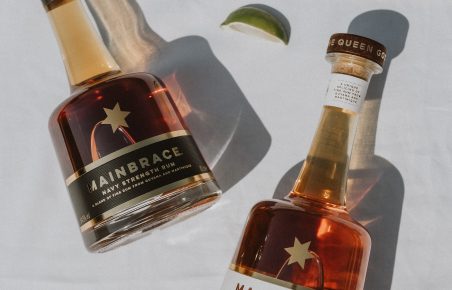
Two editions of Mainbrace Rum
Co-founder Liam Jones recommends the following serves:-
– 50ml Mainbrace Navy Strength Rum
– 25ml Lime Juice
– 10ml Sugar Syrup
or
– 60ml Mainbrace Golden Rum
– 30ml Lime Juice
– 15ml Sugar Syrup
You can read the story of Mainbrace Rum here, which contains an exclusive interview for Ryebeck.
Mainbrace Premium Golden Rum (40% ABV) costs £33.99 from Drink Finder (RRP £34.99), while the Limited Edition Navy Strength Rum is £44.99, also from Drink Finder.
Ryebeck’s expert advice on making spirits
Ryebeck supplies used or new top quality stills for all your distillation needs. Also, if you’re interested in making rum and already have a still, you may not even need much, if any, extra equipment. Ryebeck can offer all the expert advice you need, so do get in touch via their online form or give the team a call on +44 (0) 800 689 3216.
Author: Robin Goldsmith of The Write Taste.


